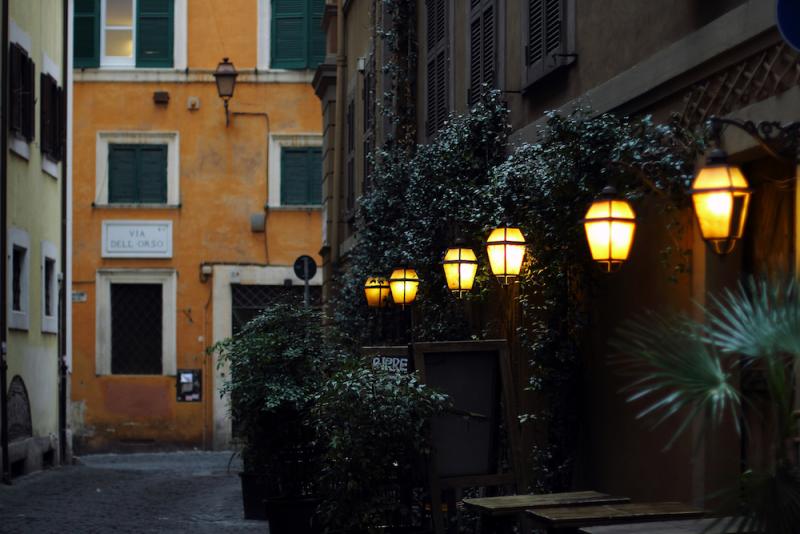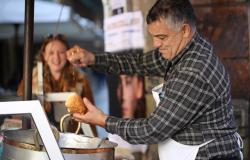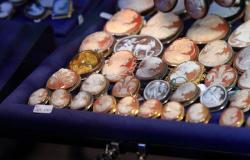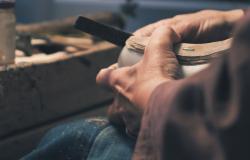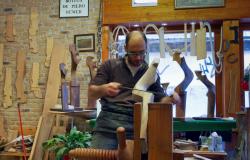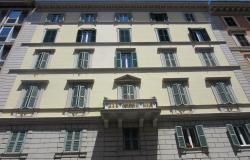[Main photo credit: Rome via dell'Orso CC via Flickr (c) Bruno.jpg]
Italy is the world’s largest exporter of gold jewelry, but Italians also keep much of their country’s gold production at home. In fact, it is estimated that there is a jewelry shop for every 2,200 Italians, three times as many as in France or Germany. There’s no doubt that Italians love to make and wear gold adornments, a tradition that goes back to ancient times.
Ancient Origins
One of the most enduring craft traditions of Rome is the working of gold, silver, and other metals. The ancient Romans inherited an already rich tradition of goldsmithing from the Greeks and Etruscans, who occupied settlements across central and southern Italy. Specialized metalsmiths passed their trades through the generations, master to apprentice. In small workshops, they turned out gold necklaces, earrings, bracelets, buckles, and other finery.
In ancient Roman times, goldsmiths began with ingots, or blocks of gold, that they hammered into sheets. The raw gold was more pure—that is, less adulterated with copper and alloys than the gold we use today—and it was therefore much softer and more malleable. This purity accounts for the remarkable brilliance—and fragility—of the ancient pieces displayed in today's museum collections. Many artisans used gems, semi-precious stones, and colored glass in their designs.

[Roman carnelian ring 2-3 century AD CC Metropolitan Museum of Art.jpg]
In a densely populated city like ancient Rome, workers of precious metals occupied cramped spaces, often small studios within or attached to their homes. They hunched over narrow workbenches with various drawers for tools, and fabric pouches or “catches” to hold tools and dropped items, which might be hot. A small slab of charcoal, which retained heat, provided the primary workspace, heated with an open flame from an oil lamp.
No matter what the technique or desired result, working precious metals began with heating them in order to make them malleable. Working at such a small scale and in close proximity to their work, jewelers had to come up with ways to heat metal with a small source. The invention of the foot bellows allowed a jeweler to work at a small bench and control the airflow to a flame with some precision. Goldsmiths often hammered, flattened, or otherwise formed a piece while the metal was in this molten state. Roman jewelers of centuries past also used metal molds that aided them in forming a piece into the shape they wanted.
Jewelers worked with a variety of stones, files, and buffers to achieve particular effects, as well as a foot-powered wheel to grind away or file hard edges. Their workbenches also included liquid and powdered chemicals (borax, sulfur, potash, lime, or other materials) used to form, bind, and add color to metals. These chemicals, along with the open flame the artisans needed to soften metal, posed certain occupational hazards.
Today, small blowtorches and other high-tech methods have replaced the open fire that once stood at the heart of the goldsmith's studio. However, many of the tools today's artisan jeweler uses remain more or less unchanged: small metal hammers, anvils, tongs, chisels, molds, dies, stamps, abrasives, and engraving tools.

What to Look For
It would be easy to fill a book with terminology and techniques related to the making of jewelry in precious metals. Roman goldsmithing is a complex art with many different techniques and combinations, as well as a rich history. Without diving too deeply into the technical details, here are some of the main types of ancient metalworking that endure today.
Filigree
The word filigree joins together two Latin roots, filium (“thread”) and granum (“grain”), which describes the technique in a nutshell. Filigree involves twisting threads of silver or gold, and/or adhering tiny beads to achieve a granulated surface. The goldsmith may twist, curl, or braid fine wires into a pattern, connecting separate pieces by heating them with a flame from a blowpipe, and joining them with flux (one or more chemical agents used in jewelry making).
Granulation involves soldering together miniscule metal beads, sometimes on a flat metal surface. Filigree was used widely in antiquity, as far back as the ancient Mesopotamian and Egyptian civilizations. In Renaissance Italy, metalsmiths often employed filigree to embellish headpieces, as seen in many portraits of the era.

[Roman era encaustic funerary portrait from Egypt 120-140AD showing gold jewelry CC Metropolitan Museum of Art.jpg]
Cameos and intaglio
In jewelry, intaglio refers to engraving or cutting an image into the flat background of a gemstone such as sardonyx or carnelian. Conversely, cameos involve relief carvings, or designing an image to project out of a background composed of a gem or seashell cut with small hand tools and abrasive or powdered stones. Cameos and engraved gemstones were popular among the ancient Greeks and Romans. There was a renewed taste for engraved gems during the Renaissance, when jewelers began to replicate these ancient designs.
Precious stones
During the Middle Ages and the Renaissance, Europeans appreciated sapphires, rubies, garnets, and emeralds. To highlight the beauty of these precious stones, the goldsmithing that went along with them remained relatively understated. Pearls were among the most popular precious stones, worn as jewelry but also commonly used in embroidery to embellish collars, cuffs, headdresses, and buttons. They were also used in hairnets and to stud more elaborate hairstyles.
Buying Gold Jewelry in Italy
Gold is measured in karats, indicating the amount of pure gold that constitutes a piece of jewelry. Twenty-four karats (24k) designates gold in its purest state. However, twenty-four-karat gold is too soft to be used in jewelry making.
By mixing pure gold with other alloys such as silver or copper, it can be worked by a jeweler. For example, an eighteen-karat gold ring contains seventy-five percent pure gold. In other words, it contains eighteen parts gold and six parts another metal or metals. This information is important when pricing gold jewelry in Italy, since some jewelers sell gold jewelry based on weight alone, tagging the price of their work to the varying values in the gold market.
In the U.S., ten karats is the lowest legal standard at which a piece of jewelry can be referred to as “gold,” though fourteen-karat gold is the most popular. In Italy, however, eighteen karats is the lowest legal standard to carry the label “gold.” This higher percentage of gold helps explain why gold jewelry in Italy seems more brilliant and also softer. This preference for more “pure” gold goes back to antiquity, as the ancient Romans preferred to use a more unadulterated form of brilliant gold as a raw material for jewelry.
By combining gold with different metals such as copper and silver, jewelers can achieve different coloration. In Rome, you will see different shades of gold combined together. Rose gold (oro rosa) is achieved by combining gold with copper. White gold (oro bianco) combines gold with copper, nickel, and zinc. Yellow gold (oro giallo) combines gold with copper and silver.
Prices for Italian gold jewelry vary according to three main factors:
- The weight of the gold, priced according to the fluctuating market values of precious metals
- The techniques used to execute the piece. Expect to pay more for custom and intricate designs
- The repute of the maker, especially if you buy from one of the famous brand fashion houses, which command higher prices because of the cachet behind their names.
Buying directly from an artisan jeweler is the best guarantee of getting an authentic piece for the best possible value. If you can resist the allure of the many jewelry shop windows and instead head to a good artisan goldsmith with a workbench set up inside the studio, you may be lucky enough to watch small masterpieces in development.
Traditional Artisan Jewelers

[Basilica di Sant Eustachio in Campo Marzio in the City Center of Rome, on a popular shopping street]
To learn more about the heritage of Roman goldsmithing, visit one of the city’s excellent museums. The Musei Capitolini and the Museo Etrusco Gregoriano, part of the Vatican Museums, carry impressive collections of Etruscan and Roman jewelry, and can help develop your eye for classical forms and styles.
If you're serious about coming home with an authentic piece of Roman gold, make an appointment with an artisan goldsmith, and collaborate on the design of your dreams. It's in custom work that you'll witness their skills and passion truly shine. Best of all, you'll go home with a tiny treasure you will value as much for its superb craftsmanship as for its connection to the ancient past.
- Andrea Dolcetti, Vicolo Domizio, 3, 06/89674798
- Massimo Nocerino, Via Francesco Crispi, 94, 06/4882189
- Gioielli Simonelli, Via Laurina, 15, 039/063243330
Other artisan goldsmiths are clustered between the Colosseum and Vatican City (try the via del Clementino, the Campo Marzio, and surrounding streets); the Campo de Fiori, the Ponte Sisto near via Giulia, via dei Coronari, via dell’Orso, and via del Pellegrino.
Laura Morelli is an art historian and historical novelist with a passion for Italy. You can find her guidebook series, including Made in Naples & the Amalfi Coast and Made in Italy, as well as her IPPY-award-winning historical novel, The Gondola Maker, in the Italy Magazine shop.
